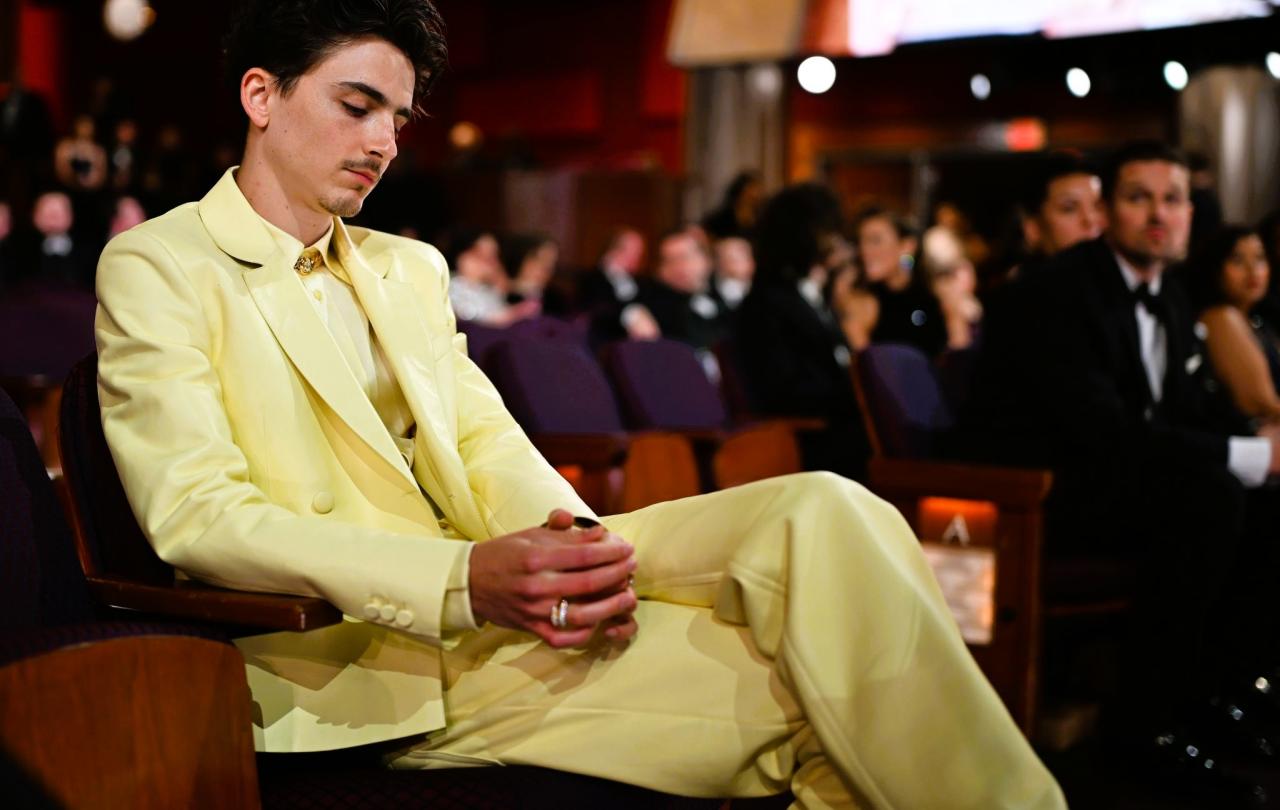
So, Timothée Chalamet didn’t win the Oscar. I feel sad for him. No one has campaigned for an Oscar more persistently. For the last few months he has been everywhere- popping up on podcasts, cruising with Kendrick Lamar, riding a bike to the red carpet, appearing as Timothée Chalamet in a Timothée Chalamet look-alike competition. All to win the hearts and minds of the academy. Even if his acting didn’t get him an Oscar, his Oscar campaign deserves one.
And Oscar campaigns are big business. Ever since Harvey Weinstein upped the game, every studio has invested vast amounts in getting their film on the podium. The 97th Academy Awards (2025) paused briefly for an emotional reflection on the Palisades fires, a cause for which the Hollywood studios donated somewhere between five to fifteen million dollars. But I doubt they are as keen to a pause on the estimated half a billion dollars they each spent for their film to be at the awards in the first place.
On the night itself, Chalamet lost out on being the youngest ever winner of the best actor award, to the previous (and therefore current) youngest ever winner, Adrien Brodie. Up to that point he seemed to be a shoo-in. The Golden Globe was his. The SAG award was his. And his campaign was charming. Most people, including me, really like him. He was great as Paul Atreides in Dune. And as Wonka in, er… Wonka. And as [insert male character here] in Little Women – or was it Little House on the Prairie? (I always get those two mixed up). And, while I haven’t seen A Complete Unknown yet, the reports suggest he so embodied Bob Dylan on screen that he now needs an exorcism more than an Oscar. He deserves the awards.
But his acceptance speech at the SAG award was informative. He does the usual – thanks his mum, the cast and crew – and then takes an abrupt left turn to address his pursuit of greatness. He acknowledges it is an unusual thing to say but makes it clear that he aims to be like his heroes – Daniel Day-Lewis, Marlon Brando, Viola Davis, both Michaels (Jordan and Phelps), indeed Dylan himself. But it is not entirely clear what he means by greatness. Does he mean virtuosity in the craft of acting? Or fame? Or both? If he doesn’t win the Oscar, will he still be great?
Way back when in the mid-1980s, before podcasts and Oscar campaigns, literary scholar Leo Braudy published an ambitious book telling the story of Western civilisation through the lens of fame. The Frenzy of Renown argues that fame as we know it began with Alexander the Great, whose artefacts and exploits were designed to spread his name across the known world. He in turn became the model of godlike fame for Julius Caesar and the Romans.
With the birth of Christianity, things became a little more confused. Fame and renown became ambivalent pursuits in a cosmos where true lasting greatness was conceived as greatness in the eyes of God. This was what allowed men and women to vanish anonymously into deserts and monasteries believing their names would be erased from the world but written in heaven. So many monastics went to their deaths issuing instructions for their writings to be burned, only to be disobeyed by zealous acolytes who disseminated their teaching in every conceivable direction. They must be delighted, gazing down from their heavenly repose, to see the pages they consigned to the flames available with 1-Click on Amazon.
Approaching the modern era though, fame in its old guise returned with a vengeance. The Renaissance rediscovery of ancient Greece and Rome, and the invention of the printing press, allowed images and words to find a mass audience. Even Christians became less enamoured with retreating into monasteries, and more concerned with reaching the public. Thanks to this new technology, Luther in his most productive period produced more literature than all his opponents put together. He was the original early adopter. The church had never seen anything like it- a heretic who would not shut up.
But he wasn’t the only heretic. Many who followed craved his fame but lacked his faith. Over time widespread belief in heaven eroded but the desire for life beyond death lingered. With no assurance of a God capable of remembering us, the only remaining option was to be remembered by others- ideally as many others as possible. By the nineteenth century Nietzsche was re-writing the words of Jesus. ‘He who humbles himself will be exalted’, said the gospels. But Nietzsche added a new cynical twist: ‘he who humbles himself wants to be exalted’. The age of the humblebrag had arrived. Even those who claim indifference to fame were not to be believed, they were simply pursuing notoriety by other means. Only two choices remained: the glories of fame or resentful anonymity. For the ancients immortality lay in fame. For the medievals it lay in heaven. But we live in a hybrid era – fame is the new heaven.
So, when Chalamet speaks of greatness maybe he is just being honest. Maybe he is just saying out loud what most of us keep to ourselves. We fear being forgotten and to be great is to be remembered.
And given that the self is not an object, not really a thing at all, any attempt to sum ourselves up with a tag line or a meme diminishes us even when intended to promote us.
But there is a rarely acknowledged paradox to greatness. A paradox reflected in the way many English bible translations use the word ambition. At face value we could be forgiven for thinking the biblical writers were just plain confused about it. In one letter the apostle Paul warns us against ambition and in another he claims he’s relentlessly ambitious. Ambition is the worst of sins and somehow also the most commendable of attitudes. Make up your mind Paul! Which is it: ambition or no ambition?
When peering under the hood of the English translation, we discover that ‘ambition’ is used to render two Greek terms that couldn’t be more different. One of them (the root word eritheia) is usually translated selfish ambition. Paul says it is unanimously bad. So bad in fact, he tells the Philippians not to do anything out of selfish ambition. It connotes strife and electioneering- the kind of self-interest that creates factions for its own advantage. Not one for the character wish-list.
The other term for ambition strikes a markedly more wholesome tone. Paul uses it for his ambitions to preach and his desire to please God. At root, it’s the word philotimeomai, literally meaning the pursuit of that which is honourable. It forms the basis for arguably one of the most beautiful instructions in the entire canon: ‘Make it your ambition to lead a quiet life: You should mind your own business and work with your hands’. It speaks of the love, honour and inner stillness associated with the privilege of rising to a task. A contentment with life few of us ever achieve.
Two qualitatively different experiences of ambition. One is the attentiveness that any serious person brings to whatever it is that occupies them. It’s how parents parent, how governors govern, how coders code, how actors act. It is the desire to do whatever we do well. The other is the desire for other people to know about it. When Chalamet speaks of greatness of course he means mastering the craft of the actor, but he also means gaining the recognition for having done so. He, like many of us, collapses two motives into one. The idea of being great without being seen-as-great becomes unimaginable. But being something, and being seen as something, are not the same something.
Just contrast the experience of self we have in these two different pursuits. When we pursue excellence or skill – whether in painting or parenting, surfing or science – we generally achieve a state of self-forgetfulness. We do not think of ourselves but of that which we wish to master. We become absorbed in the challenge of learning the subtle nuances of our craft. If we get good at it, we know we are good at it, not because we’ve formed a high opinion of ourselves, but because we have repeated experience of doing it well. This can lead to something that looks like arrogance. Add a crowd and our performance is likely to improve. Challenge us to show our skill and we’re ready to prove it. We’d be idiotic to deny what we know in our bones.
But in promoting ourselves, we relate to our self in a different way. Instead of forgetting the self in pursuit of something beyond the self, we construct a self to promote. The self becomes an object, a commodity, a list of saleable assets for the market. And given that the self is not an object, not really a thing at all, any attempt to sum ourselves up with a tag line or a meme diminishes us even when intended to promote us.
Even worse, if we get stuck in the mode of self-promotion it can be so vivid and enticing, we lose touch with the moment-by-moment, concrete reality of our embodied existence.
Who we imagine ourselves to be becomes hyper-real, more real to us than who we actually are. Life becomes an unwelcome interruption to our dreams. We gain the world but we lose our souls. It was the fear of this condition that provoked Thomas Merton to profanity in warning against it:
If I had a message to my contemporaries, it is surely this: Be anything you like, be madmen, drunks, and bastards of every shape and form, but at all costs avoid one thing: success . . . If you are too obsessed with success, you will forget to live.
If I had a prayer for Timothée Chalamet, it would be for greatness without self-consciousness. May he rise to the full magnificence of all he is meant to be without needing to know it. It is my prayer for all of us.
Join with us - Behind the Seen
Seen & Unseen is free for everyone and is made possible through the generosity of our amazing community of supporters.
If you’re enjoying Seen & Unseen, would you consider making a gift towards our work?
Alongside other benefits (book discounts etc.), you’ll receive an extra fortnightly email from me sharing what I’m reading and my reflections on the ideas that are shaping our times.
Graham Tomlin
Editor-in-Chief





